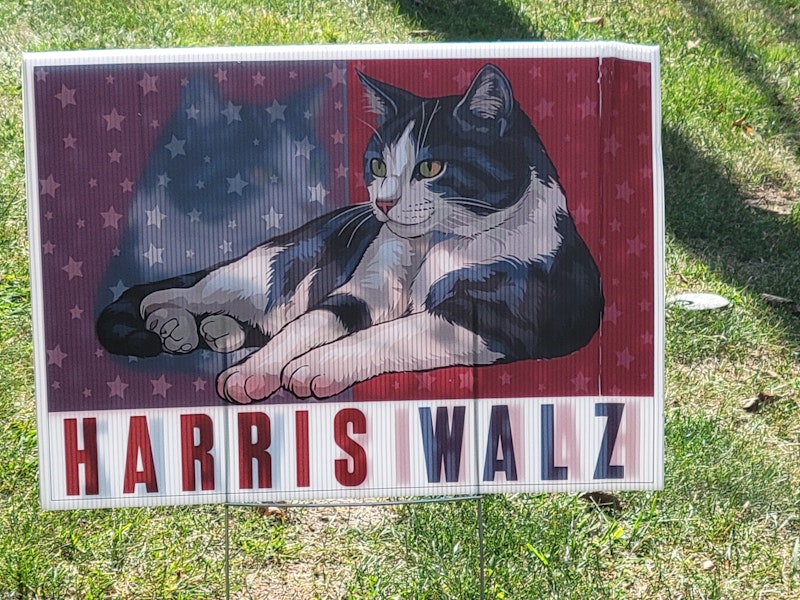On my street in North Jersey, the balance between Trump and Harris signs is roughly even, after an early Trump lead. Someone hoisted a Trump flag onto a pole they’d stabbed into a tree, which may’ve inspired some Democratic signs to go up in the vicinity. It spurred my purchase on Etsy of a sign with a cat languidly promoting Harris-Walz; that presumably was designed in reaction to J.D. Vance’s “childless cat ladies” comments, but got more pertinent after the “Haitian cat-eating” libel. The local Democrats later offered a more-conventional sign at a lower price, but once again didn’t manage to field any candidates for the township committee, currently unanimously Republican.
New Jersey can be expected to stay blue in the presidential race, notwithstanding swathes of red, like northwestern Bergen County, where I live, and more so the Jersey Shore. We went to a wedding last weekend in Monmouth County, the Shore’s northernmost part, which is red though less so than Ocean County, its neighbor to the south. As we were about to enter a restaurant in downtown Asbury Park, a convoy of vehicles rode by, Trump flags waving, horns blaring, the lead a massive camo truck. The procession had a “show of force” vibe but was smaller than the post-assassination-attempt one in July.
Jersey’s U.S. Senate race, for the seat held for 18 years by now-indicted Democratic Sen. Bob Menendez, is between Democrat Andy Kim and Republican Curtis Bashaw. Kim has an arms-length relationship with Democratic Gov. Phil Murphy, whose wife initially sought the Senate seat. Bashaw’s a gay hotelier who supports abortion rights and gun background checks; his campaign’s a “balancing act,” supporting Donald Trump while appealing to Kamala Harris voters to split the ticket. In a post-Trump era, I might vote for someone like this, to encourage GOP moderation, if such seems plausible. By “post-Trump era,” I mean one in which the party’s leader is not Donald Trump, J.D. Vance, Donald Trump Jr., or J.D. Hamel, the name under which Vance wrote for David Frum’s FrumForum.
I couldn’t vote in Austria’s late-September elections, for which the registration deadline had been tight after I got my dual citizenship. My application brought no ballot, and my email inquiry was passed to another government office. I’ll revisit getting on the voter rolls there another time. In this election, the far-right Freedom Party won, and will now seek to form a coalition. The outgoing government was a combo of the conservative People’s Party and the environmentalist Green Party. The Freedom Party’s win is an upheaval raising dark possibilities. Some of its officials were recently heard singing an SS song.
Anti-immigration sentiment was a big factor in the electoral outcome. When we were in Vienna in July, there was one day we heard there’d be rightist demonstrations for “re-migration” (removal of immigrants) and likely left-wing counter-demonstrators. We visited Stephansplatz, where the cathedral is, which seemed tranquil though some protestors had gathered. On the metro soon after, we got reports that Stephansplatz was in turmoil, with tear gas fired, though others went there later and said it was back to normal.
I grew up in the 1970s and 1980s in Elmhurst, Queens, which had huge influxes of immigration from Asia, Latin America and elsewhere in those decades. It became not just majority non-white and majority foreign-born, but one of the most ethnically diverse places in the country, even the world. I won’t pretend there were no tensions between ethnic and racial groups in the area, or that I was never involved in confrontations among kids from different groups. Still, I thought it was normal that many of my friends were from other countries. In many ways, the neighborhood improved as immigrants moved in, reflected in higher property values. I regret I didn’t take more advantage of the exotic food choices.
A recent CNN poll asked: “Overall, do you think having an increasing number of people of many different races, ethnic groups, and nationalities in the U.S. is mostly (threatening) or mostly (enriching) American culture?” The responses were 66 percent “enriching,” 33 percent “threatening,” and one percent “no opinion.” That seems not too bad, except a similar poll five years ago had just 11 percent “threatening.”
Our school district in New Jersey, which we’ve opted not to use, has struggled in recent years. The problem isn’t a strain placed by immigrants, who aren’t particularly common where we live, but political turmoil fostered by right-wing school-board members who’ve pressed a culture war for “parents’ rights” while slashing programs such as mental-health services and spurring an exodus of administrators and teachers. This erratic oversight has also included expensive consultants and severance packages.
I was a longtime Republican, live in a predominantly Republican area, and know many people, including good friends of mine, with right-wing views of one sort or another. To me, it’s clear the right’s gone off-the-rails, in America and abroad, and heading into dangerous territory, but convincing people to jump off that train isn’t easy.
—Follow Kenneth Silber on X: @kennethsilber

